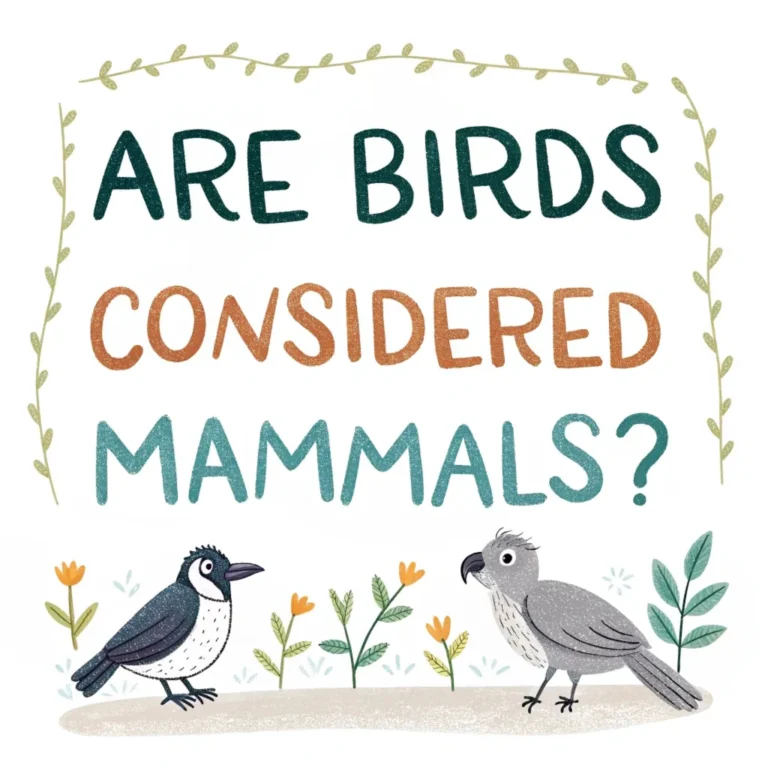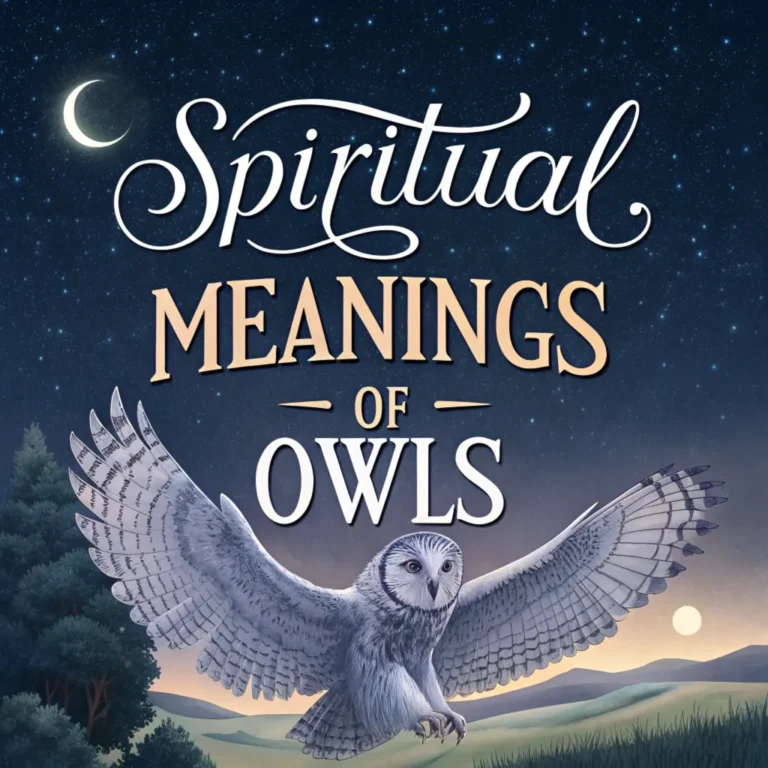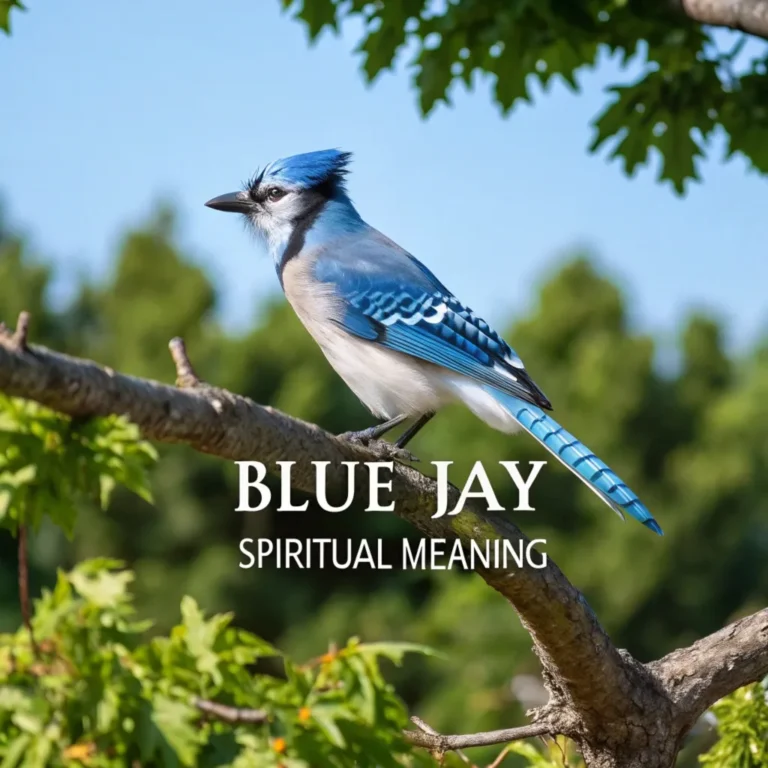10 Stunning Birds with Orange Beaks: A Colorful Guide to Nature’s Marvels
Have you ever seen a bird with a bright orange beak? These birds are special and fun to watch. Their colorful beaks make them stand out in nature.
Some birds use their orange beaks to find food, while others use them to look attractive to other birds. In this guide, we will learn about ten different birds that have orange beaks.
We will discover where they live, what they eat, and why their beaks are so important. Get ready to explore the world of these amazing birds with their eye-catching orange beaks!

Key Takeaways
- Orange beaks in birds often indicate good health and breeding fitness
- Many birds with orange beaks are found near water bodies or in tropical regions
- The color intensity of orange beaks can vary with seasons and diet
- Some orange-beaked birds are popular in aviculture due to their striking appearance
- Conservation efforts are crucial for protecting several orange-beaked bird species
- Carotenoid pigments in their diet contribute to the orange coloration of beaks
- Orange beaks often serve multiple functions, including foraging and mate attraction
- Observing these birds can provide insights into avian behavior and ecology
- Many orange-beaked birds play important roles in their ecosystems as pollinators or seed dispersers
- Climate change and habitat loss pose significant threats to several orange-beaked bird species
The fascinating world of orange-beaked birds offers a unique glimpse into the diversity of avian adaptations. These birds have evolved their distinctive beaks to suit various ecological niches, from cracking seeds to probing for insects or scooping fish from water.
The vibrant orange color not only serves functional purposes but also plays a crucial role in communication and mate selection within bird communities.
Studying these orange-beaked species provides valuable insights into bird biology, evolution, and conservation.
As we delve into the details of each species, we’ll uncover the intricate relationships between beak color, behavior, and habitat.
American White Pelican

The American White Pelican stands out with its massive orange beak. This large water bird uses its distinctive bill to scoop up fish from shallow waters.
During breeding season, the beak develops a unique horn-like structure on the upper mandible, adding to its striking appearance.
American White Pelicans are social birds, often seen in large flocks. They work together to herd fish into shallow areas, making it easier to catch their prey. These pelicans are found near lakes, marshes, and coastal areas across North America.
The impressive size of the American White Pelican’s beak serves a crucial function in its feeding strategy. This specialized tool allows the bird to scoop up large quantities of water along with fish, which it then drains before swallowing its catch.
The beak’s expandable pouch can hold up to 3 gallons of water, making it an efficient fishing instrument.
Conservation efforts for American White Pelicans focus on protecting their breeding and foraging habitats. These birds are sensitive to disturbances and require undisturbed areas for nesting.
Atlantic Puffin
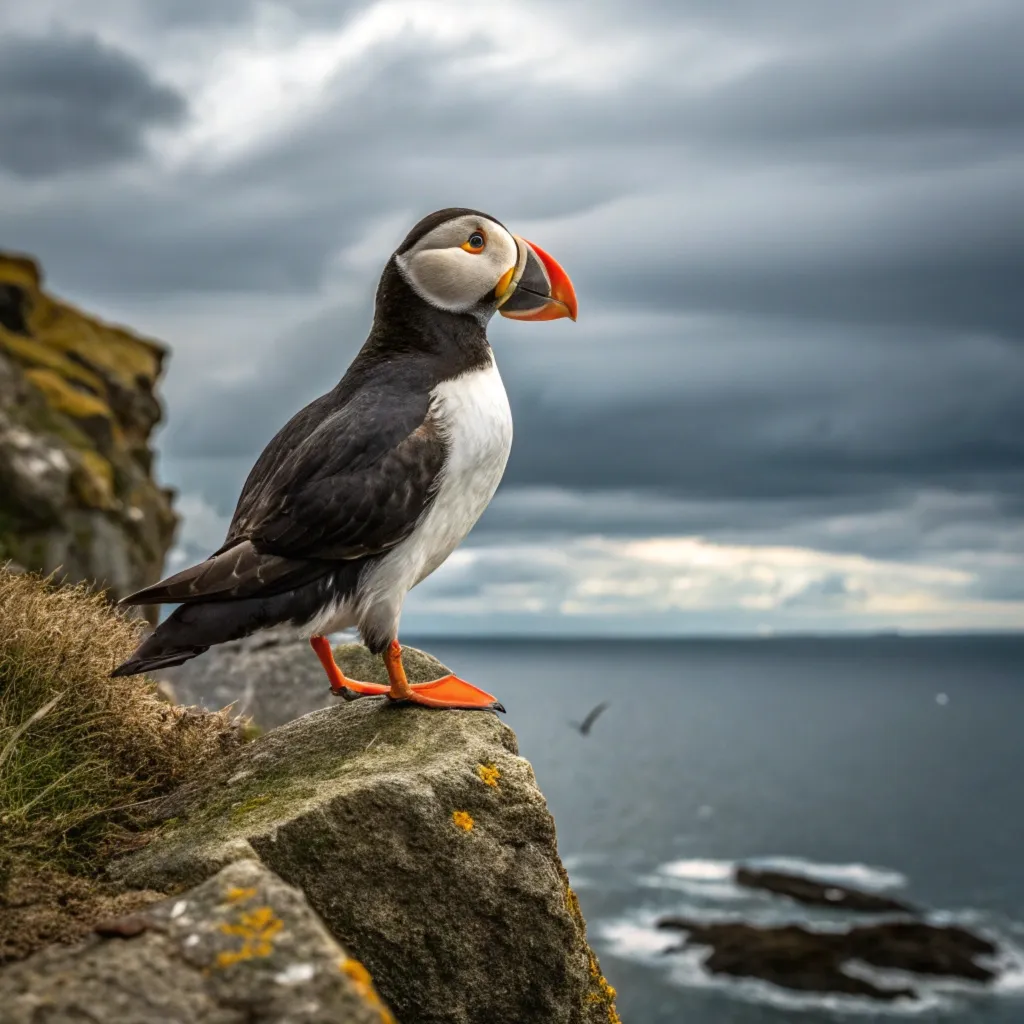
The Atlantic Puffin, often called the “clown of the sea,” boasts a colorful beak with orange, yellow, and blue hues. This seabird’s beak changes color seasonally, becoming brighter during the breeding period to attract mates.
Atlantic Puffins are excellent swimmers and divers, using their wings to “fly” underwater in pursuit of small fish. Their beaks are specially adapted to hold multiple fish at once, allowing them to bring back more food to their chicks.
The Atlantic Puffin’s beak is a marvel of nature’s engineering. During the breeding season, the beak grows additional layers of keratin, creating its distinctive shape and vibrant colors.
This transformation is triggered by hormonal changes and serves as a visual signal of the bird’s readiness to mate. The beak’s grooves and ridges also help the puffin grip fish more effectively.
Climate change poses a significant threat to Atlantic Puffins, affecting their food supply and breeding habitats. Conservation efforts focus on protecting their nesting sites and monitoring fish populations.
Toco Toucan

The Toco Toucan is famous for its enormous orange beak, which can grow up to 7.5 inches long. Despite its size, the beak is lightweight and helps the bird regulate its body temperature.
Toco Toucans are native to South America’s tropical forests. They use their long beaks to reach fruits on branches too thin to support their weight. These birds also play a crucial role in seed dispersal within their ecosystems.
The Toco Toucan’s beak is a multifunctional tool that serves purposes beyond feeding. Its large surface area, covered with a network of blood vessels, helps the bird regulate its body temperature by releasing excess heat.
This adaptation is particularly useful in the warm, humid environments where toucans live. The beak also plays a role in courtship displays and territorial disputes.
Deforestation in South America poses a significant threat to Toco Toucans. Conservation efforts focus on preserving their forest habitats and raising awareness about the importance of these charismatic birds.
Royal Tern

The Royal Tern displays a bright orange beak that contrasts beautifully with its black cap and pale gray plumage. This coastal bird is often seen along beaches and estuaries in the Americas.
Royal Terns are skilled fishers, diving into the water to catch small fish near the surface. Their orange beaks serve as a visual signal during courtship displays and help in recognizing individuals within the colony.
The Royal Tern’s beak plays a crucial role in its social interactions. During courtship, males often present fish to females, using their bright orange beaks to make the offering more conspicuous.
The beak’s color intensity can also indicate the bird’s health and fitness, potentially influencing mate choice. Royal Terns use their sharp, pointed beaks to catch fish with remarkable precision.
Coastal development and pollution threaten Royal Tern habitats. Conservation efforts focus on protecting nesting sites and maintaining healthy coastal ecosystems.
Zebra Finch
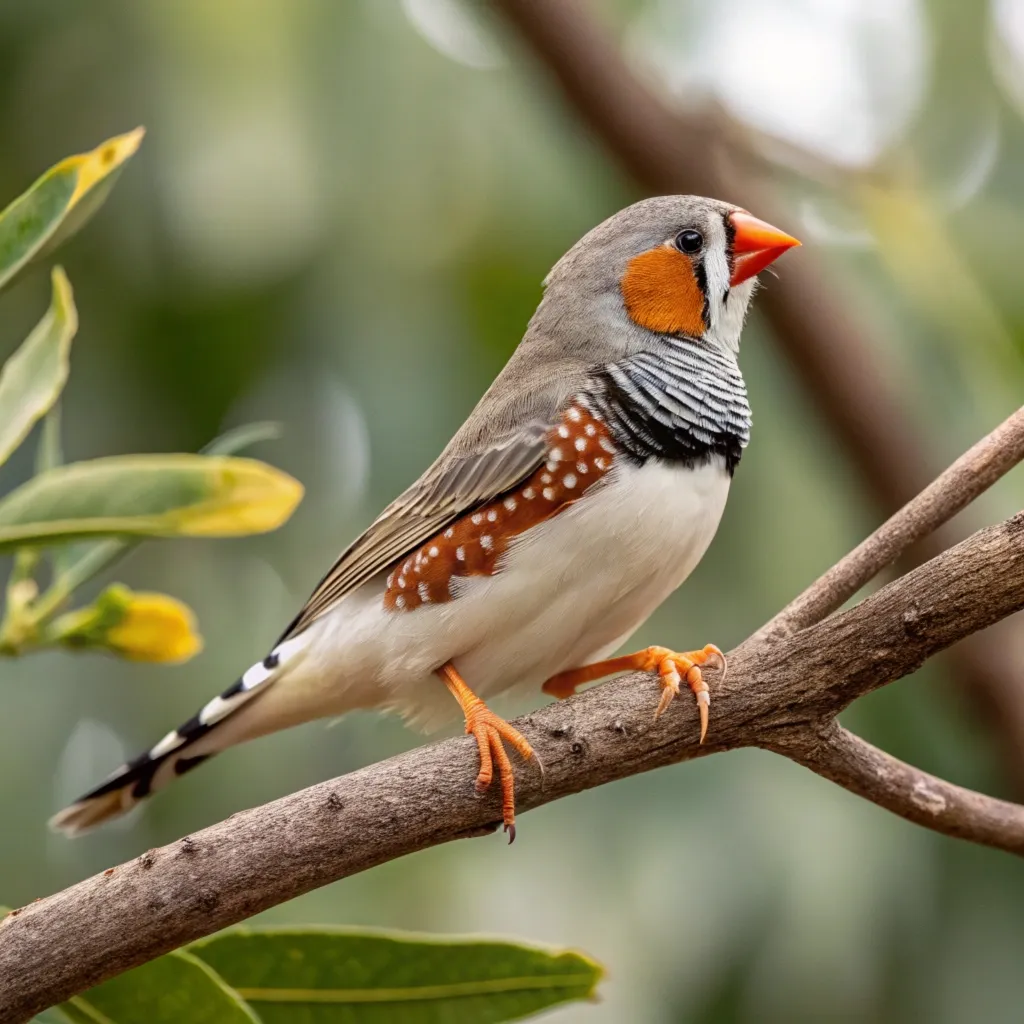
The Zebra Finch, a popular aviary bird, features a small but vibrant orange beak. Male Zebra Finches have brighter orange beaks compared to females, making it easy to distinguish between the sexes.
Native to Australia, Zebra Finches are social birds that form strong pair bonds. Their orange beaks play a role in mate selection and are believed to indicate the bird’s overall health and genetic quality.
The Zebra Finch’s beak color is influenced by both genetics and diet. Studies have shown that the intensity of the orange color can be an indicator of the bird’s carotenoid intake, which is linked to immune function and overall health.
This makes beak color an important factor in mate choice, as it can signal the potential quality of a partner’s genes.
While Zebra Finches are not currently threatened in the wild, habitat loss due to agricultural expansion is a concern. Conservation efforts focus on preserving their natural habitats in Australia.
Mute Swan

The Mute Swan is known for its graceful appearance and orange beak with a black knob at the base. This large waterfowl is native to Europe but has been introduced to many parts of the world.
Mute Swans use their orange beaks to forage for aquatic plants and small animals in shallow waters. The intensity of the orange color can vary depending on the bird’s diet and overall health.
The Mute Swan’s beak serves as both a foraging tool and a defensive weapon. The orange color is derived from carotenoid pigments in their diet, particularly from aquatic plants.
The black knob at the base of the beak, more prominent in males, plays a role in mate attraction and can also indicate the bird’s age and dominance status within a group.
In some areas, Mute Swans are considered invasive species, impacting native ecosystems. Management efforts focus on controlling populations while ensuring the welfare of individual birds.
American Oystercatcher

The American Oystercatcher has a long, bright orange beak that it uses to pry open mollusks and other shellfish. This shorebird is easily recognizable with its black and white plumage contrasting against the orange bill.
American Oystercatchers are found along coastal areas of the Americas. Their specialized beaks allow them to exploit a food source that many other birds cannot access, giving them a unique ecological niche.
The American Oystercatcher’s beak is a specialized tool perfectly adapted for its feeding habits. The long, flattened shape allows the bird to pry open shellfish with remarkable efficiency.
The bright orange color may serve as a warning to potential predators, signaling the bird’s sharp beak as a defensive weapon. This distinctive beak also plays a role in courtship displays.
Coastal development and human disturbance threaten American Oystercatcher habitats. Conservation efforts focus on protecting nesting beaches and educating the public about the importance of giving these birds space during breeding season.
Northern Cardinal

The Northern Cardinal, a beloved backyard bird in North America, sports a vibrant orange-red beak. This conical beak is perfect for cracking seeds, which form a significant part of their diet.
Male Northern Cardinals are known for their bright red plumage, which, combined with the orange beak, makes them one of the most recognizable birds in North America. Females have a more subdued coloration but still retain the distinctive orange beak.
The Northern Cardinal’s beak is not only a tool for feeding but also plays a role in their vocalizations. The strong, cone-shaped beak allows cardinals to produce their characteristic clear, whistling songs.
The bright color of the beak, along with their plumage, is maintained through a diet rich in carotenoids, reflecting the bird’s ability to find nutritious food sources.
While Northern Cardinals are not currently threatened, they face challenges from habitat loss in urban areas. Conservation efforts include promoting bird-friendly gardening practices to provide food and shelter for these popular birds.
Blackbird
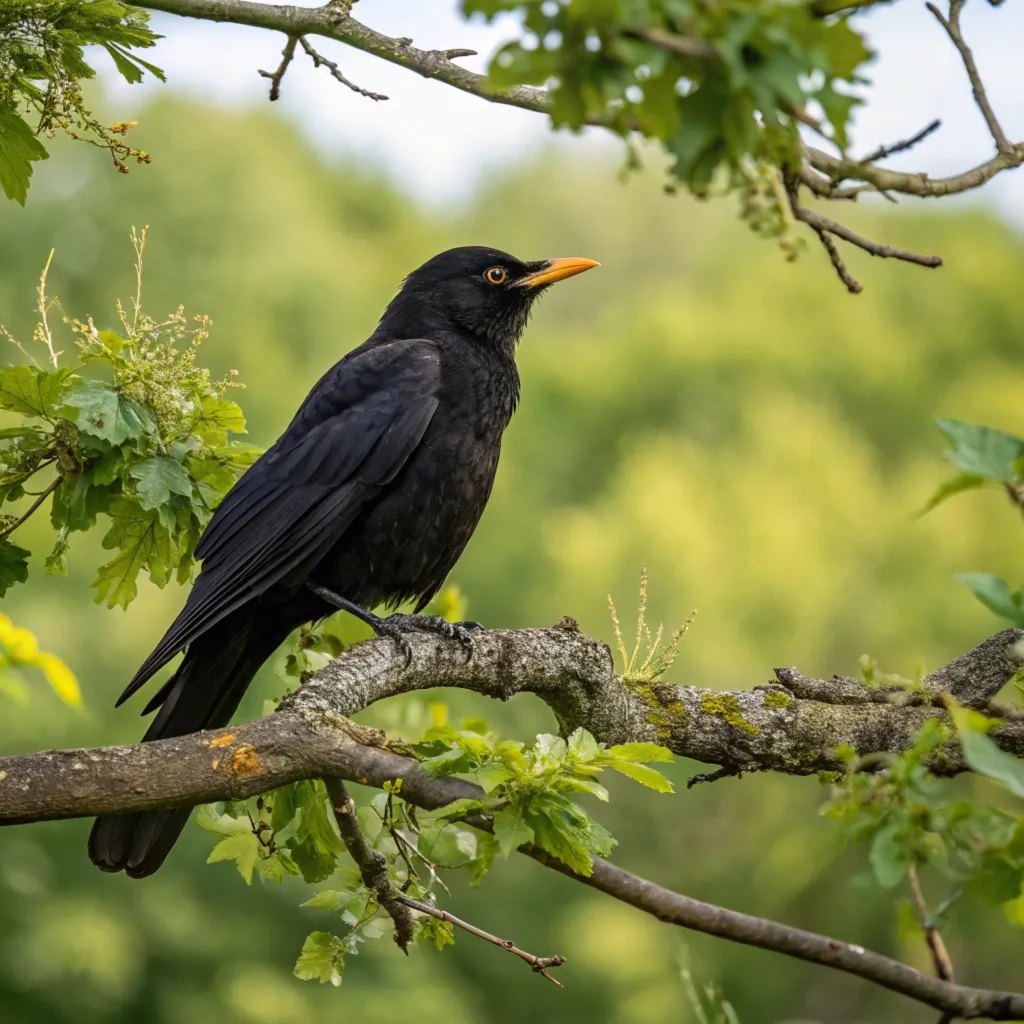
The Common Blackbird, despite its name, features a bright orange beak that stands out against its dark plumage. This contrast is particularly striking in male blackbirds.
Blackbirds are found across Europe, Asia, and North Africa. They use their orange beaks to probe the ground for insects and worms, as well as to eat berries and fruits. The beak color can vary in intensity depending on the bird’s age and overall health.
The Blackbird’s orange beak serves as a visual signal in social interactions. The brightness of the beak can indicate the bird’s age and health status, playing a role in mate selection and territorial disputes.
Young blackbirds have darker beaks that gradually brighten as they mature, providing a visual cue of their development.
Urbanization has both positive and negative effects on Blackbird populations. While they adapt well to urban environments, light pollution and changes in food availability can impact their behavior and breeding success.
King Eider
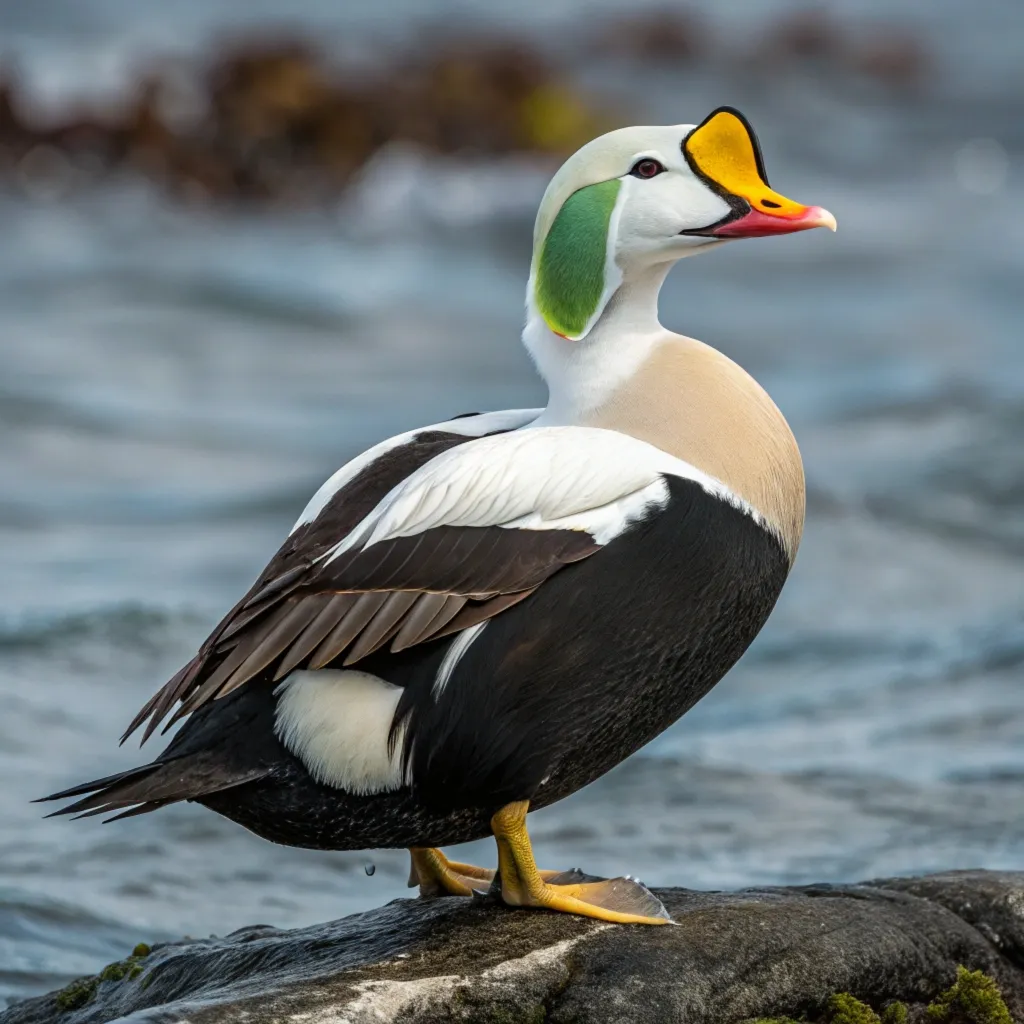
The King Eider, a sea duck found in the Arctic regions, has a unique orange beak with a distinctive bulbous shape. This feature is more pronounced in males and plays a role in courtship displays.
King Eiders are well-adapted to cold marine environments, diving to great depths to feed on mollusks and crustaceans. Their orange beaks stand out against the icy backdrop of their Arctic habitat, making them a striking sight for bird enthusiasts.
The King Eider’s beak is a remarkable adaptation to its Arctic lifestyle. The bulbous shape helps to insulate sensitive tissues from the cold water during diving.
The bright orange color, most vivid during breeding season, serves as a visual signal to potential mates, indicating the bird’s health and genetic quality.
This beak is also specially adapted for foraging in cold waters, allowing the bird to efficiently extract prey from the seabed.
Climate change poses a significant threat to King Eiders, affecting their Arctic breeding grounds and food sources. Conservation efforts focus on monitoring populations and protecting critical habitats.
FAQs About Birds with Orange Beaks
Why do some birds have orange beaks?
Orange beaks in birds often result from carotenoid pigments in their diet. These pigments can indicate good health and genetic quality, making them attractive to potential mates.
Do all birds with orange beaks live near water?
While many orange-beaked birds are found near water bodies, not all are aquatic. Species like the Northern Cardinal and Zebra Finch live in terrestrial habitats.
Can the color of a bird’s beak change?
Yes, the intensity of beak color can change due to factors like diet, season, and overall health. Some birds, like the Atlantic Puffin, have beaks that become more colorful during breeding season.
Are birds with orange beaks more aggressive?
Beak color is not directly linked to aggression. Behavior varies among species and individuals, regardless of beak color.
How do orange beaks help birds in their survival?
Orange beaks can serve multiple functions, including foraging, thermoregulation, and attracting mates. The specific benefits vary depending on the species and its habitat.
Are there any endangered birds with orange beaks?
Several orange-beaked bird species face conservation challenges. For example, the Atlantic Puffin is considered vulnerable due to climate change and overfishing.
Can I attract birds with orange beaks to my backyard?
Some orange-beaked birds, like Northern Cardinals, can be attracted to backyard feeders. Offering a variety of seeds and creating a bird-friendly environment can help.
Do juvenile birds have the same beak color as adults?
In many species, juvenile birds have duller beak colors that brighten as they mature. This change is often linked to sexual maturity.
How do scientists study the function of orange beaks in birds?
Researchers use various methods, including behavioral observations, genetic studies, and experiments manipulating beak color, to understand the role of orange beaks in bird biology.
Are there any cultural significance to birds with orange beaks?
Many orange-beaked birds, such as the Toco Toucan and Northern Cardinal, have cultural significance in various societies and are often featured in art, literature, and folklore.

Joyce is the passionate founder of Chirping Hearts, a website dedicated to sharing her love for birds and providing valuable information about avian life. With a background in ornithology and years of experience in birdwatching, Joyce aims to inspire others to appreciate the beauty and diversity of birds. Through her engaging articles and guides, she hopes to foster a community of bird enthusiasts who share her enthusiasm for these incredible creatures. When she’s not writing, Joyce enjoys exploring nature trails and observing birds in their natural habitats.


